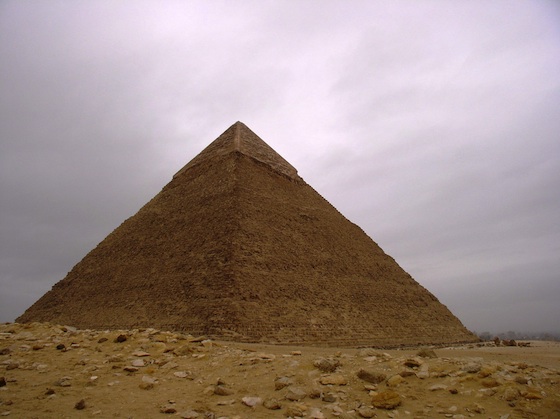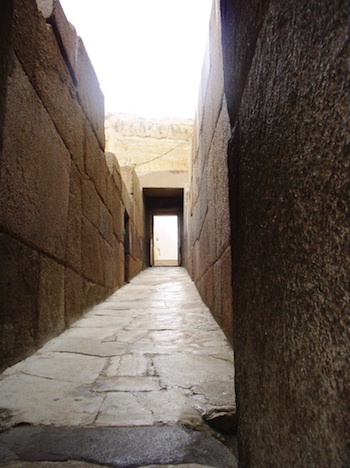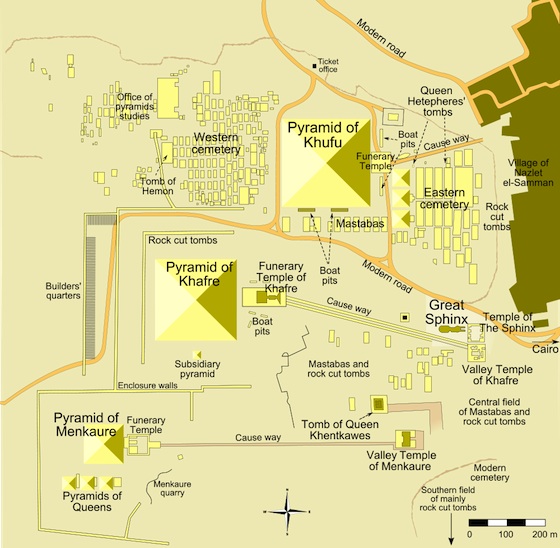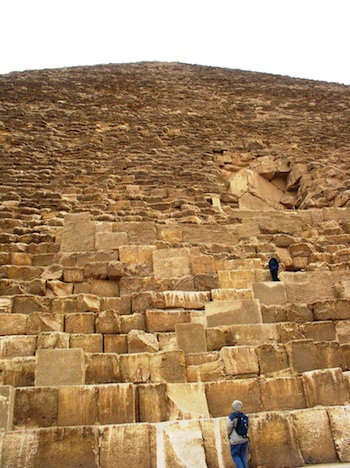4.7: The Great Pyramids of Giza
- Page ID
- 22851
One of the Seven Wonders of the Ancient World

The last remaining of the Seven Wonders of the ancient world, the great pyramids of Giza are perhaps the most famous and discussed structures in history. These massive monuments were unsurpassed in height for thousands of years after their construction and continue to amaze and enthrall us with their overwhelming mass and seemingly impossible perfection. Their exacting orientation and mind-boggling construction has elicited many theories about their origins, including unsupported suggestions that they had extra-terrestrial impetus. However, by examining the several hundred years prior to their emergence on the Giza plateau, it becomes clear that these incredible structures were the result of many experiments, some more successful than others, and represent an apogee in the development of the royal mortuary complex.
Three Pyramids, Three Rulers

The three primary pyramids on the Giza plateau were built over the span of three generations by the rulers Khufu, Khafre, and Menkaure. Each pyramid was part of a royal mortuary complex that also included a temple at its base and a long stone causeway (some nearly 1 kilometer in length) leading east from the plateau to a valley temple on the edge of the floodplain.
Other (Smaller) Pyramids, and Small Tombs
In addition to these major structures, several smaller pyramids belonging to queens are arranged as satellites. A major cemetery of smaller tombs, known as mastabas (Arabic for bench in reference to their shape—flat-roofed, rectangular, with sloping sides), fills the area to the east and west of the pyramid of Khufu and were constructed in a grid-like pattern for prominent members of the court. Being buried near the pharaoh was a great honor and helped ensure a prized place in the afterlife.

A Reference to the Sun
The shape of the pyramid was a solar reference, perhaps intended as a solidified version of the rays of the sun. Texts talk about the sun’s rays as a ramp the pharaoh mounts to climb to the sky—the earliest pyramids, such as the Step Pyramid of Djoser at Saqqara—were actually designed as a staircase. The pyramid was also clearly connected to the sacred ben-ben stone, an icon of the primeval mound that was considered the place of initial creation. The pyramid was considered a place of regeneration for the deceased ruler.
Construction

Many questions remain about the construction of these massive monuments, and theories abound as to the actual methods used. The workforce needed to build these structures is also still much discussed. Discovery of a town for workers to the south of the plateau has offered some answers. It is likely that there was a permanent group of skilled craftsmen and builders who were supplemented by seasonal crews of approximately 2,000 conscripted peasants. These crews were divided into gangs of 200 men, with each group further divided into teams of 20. Experiments indicate that these groups of 20 men could haul the 2.5 ton blocks from quarry to pyramid in about 20 minutes, their path eased by a lubricated surface of wet silt. An estimated 340 stones could be moved daily from quarry to construction site, particularly when one considers that many of the blocks (such as those in the upper courses) were considerably smaller.

